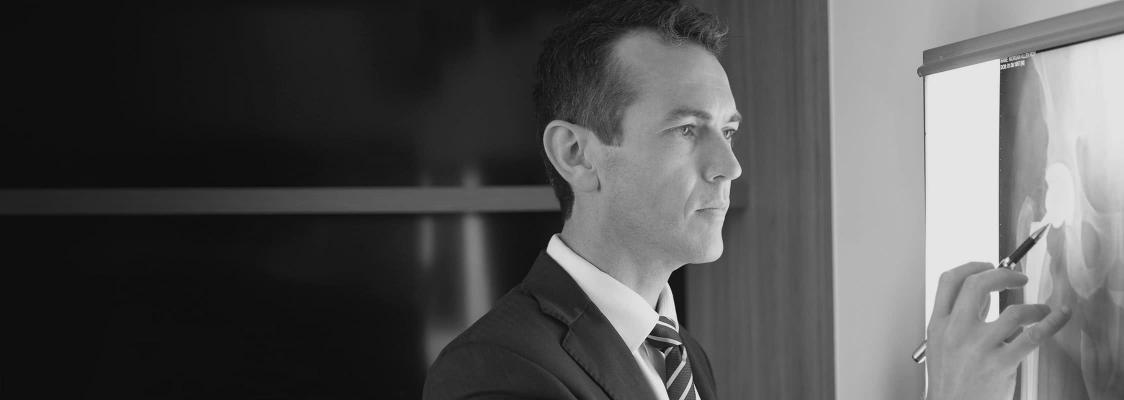The knee joint is the highly mobile joint between the end of the femur (thigh bone), the top of the tibia (shin bone) and the rear surface of the patella (knee cap) – all three of these bones, their supporting ligaments and the surrounding musculature and soft tissues (including the meniscal cartilages) interact in a highly complex manner in order for a healthy knee joint to function normally.
There are three distinct anatomical regions within the knee joint. At the inner (medial) side of the knee there is an articulation between the medial femur and the medial tibia called the medial compartment. At the outer (lateral) side of the knee is a similar articulation called the lateral compartment. There is a third articulation between the rear surface of the patella and the front of the femur bone – this being called the patella-femoral joint.
Unfortunately, the knee joint can fail. It becomes painful, stiff, swollen and unable to fully straighten. A progressive change in shape (such as a bow-legged or knock knee deformity) can develop. Wearing of the knee joint can be due to a multitude of reasons, including osteoarthritis (age related wear and tear), other forms of arthritis (such as rheumatoid arthritis) or following on from previous knee injury (post-traumatic arthritis).
Osteoarthritis is the most common form of knee arthritis and is commonly thought of as age related “wear and tear”. This condition is caused by the progressive roughening, break down and then loss of articular cartilage within the joint. The articular cartilage is the smooth & shiny surface cartilage that covers the ends of the bones inside the joint. As the cartilage surface degrades and is lost, the underlying bone surfaces become exposed. In severe arthritis, all cartilage is lost and the knee becomes “bone on bone”. Other forms of “inflammatory arthritis,” such as rheumatoid arthritis, follow a similar pattern – the difference being that in osteoarthritis the cartilage loss is due to mechanical wearing whereas in rheumatoid and other inflammatory arthritis conditions cartilage loss is due to the body’s own immune system attacking cartilage as part of an autoimmune disease.
Most frequently, it is the cartilage surfaces on the inner (medial) side of the knee that wear most rapidly. The uneven wear between the inner and outer sides of the knee causes the whole leg to change its alignment – the leg slowly develops a bow-legged appearance (varus deformity). Less frequently, arthritis can predominantly affect the outer (lateral) side of the knee, giving rise to knock-knee appearance (valgus deformity).
The knee can develop an accelerated form of osteoarthritis (called post-traumatic osteoarthritis) following on from past knee injury (such as fractures into the joint, significant meniscus injury or ligament tears). An easy analogy to describe the process is to think of the knee joint as being similar to a gearbox in a car – just like a gearbox, the knee is composed of many inter-related components that need to mesh together seamlessly with very fine tolerances in order to function normally. If one component has been previously injured and is “out of alignment” to even a minor degree, then this can cause the entire system to mechanically wear out prematurely.
As knee arthritis (of any form) has develops, there is usually much that can be done to help manage the symptoms without resorting to surgery. Surgery is reserved as the final option once all simpler strategies have been trialled.
Non-operative strategies for management of knee arthritis will be discussed and explored in depth during consultation. It may be that these have already been used and have now failed. Alternatively, there may be significant scope to control the arthritis symptoms by employing various non-operative strategies. These include weight loss, pain relief, physiotherapy, non-impact exercise, splinting/bracing, dietary supplements and injection treatments into the knee. Please see the patient information sheet titled “Non-operative management of knee arthritis” for more details.
If non-operative management has failed (symptoms or function-loss remain at an unacceptable level), then surgical treatment of knee arthritis may be appropriate. This usually consists of some form of Joint Replacement Surgery (either Total Knee Replacement or Partial Knee Replacement) or of surgery to alter the alignment of the leg and move pressure/force from the worn region of the knee to a healthy region of the knee (High Tibial Osteotomy Surgery). In most instances, simple arthroscopic (keyhole) cleanouts of the knee are not appropriate. Repeated studies demonstrate that arthroscopy in the setting of arthritis does nothing to relieve arthritis symptoms and may, in fact, worsen symptoms.
For further information regarding the operative treatments for knee arthritis, please see the sections titled Knee Replacement Surgery and High Tibial Osteotomy.
